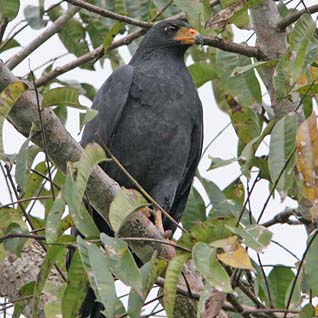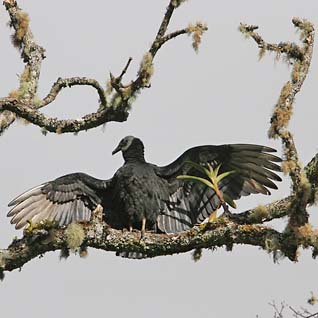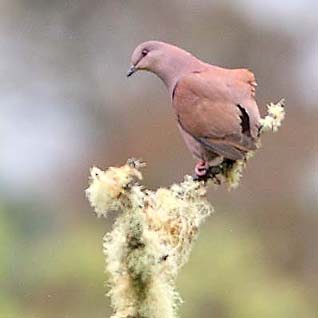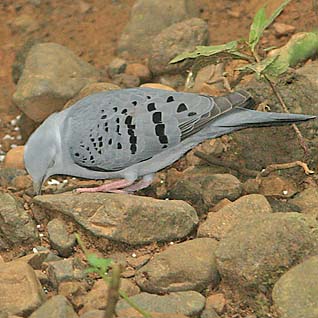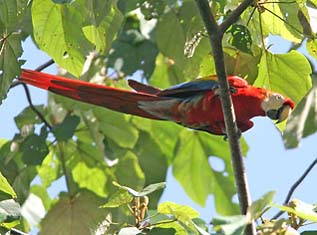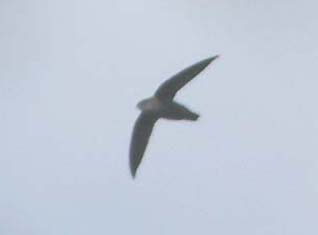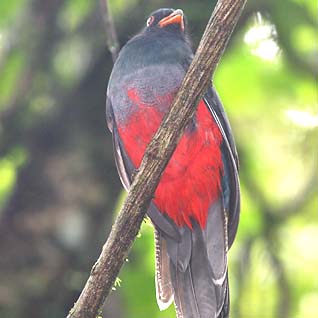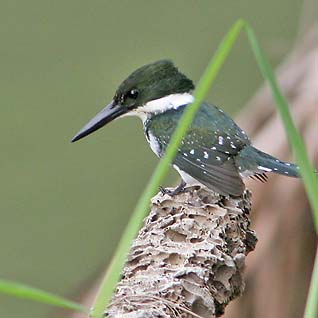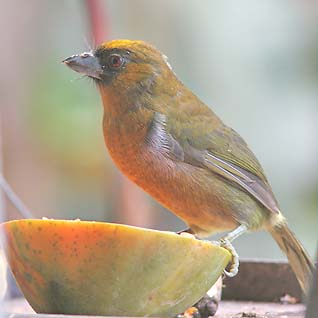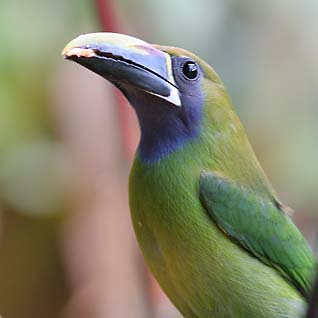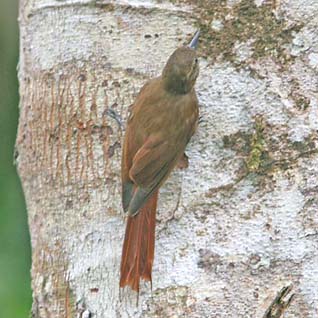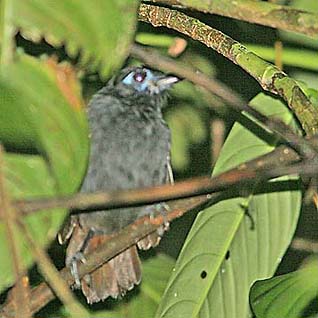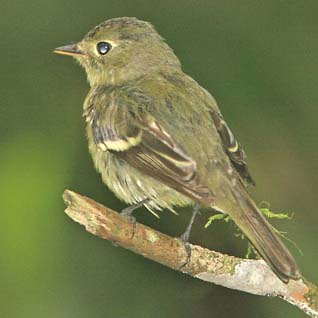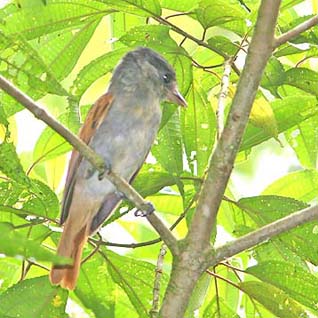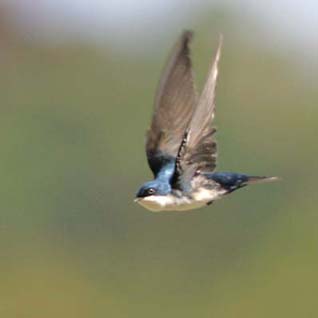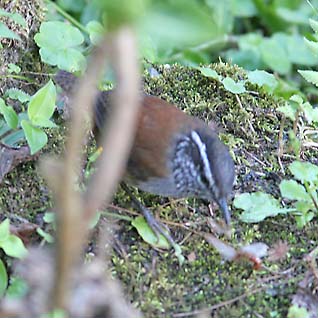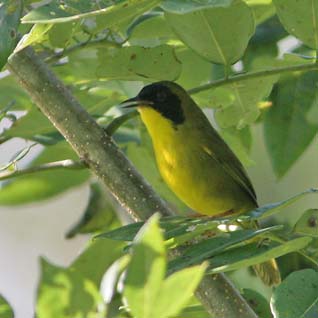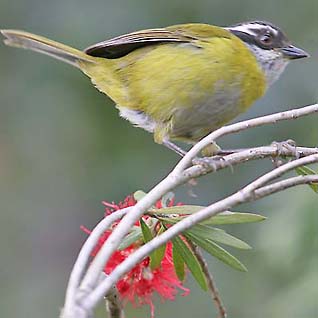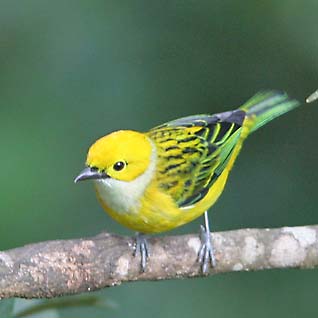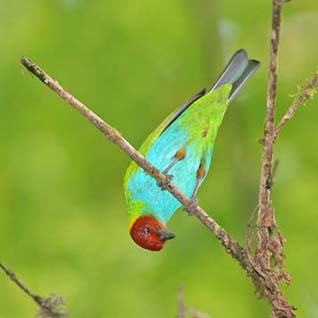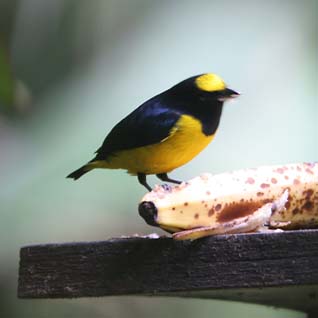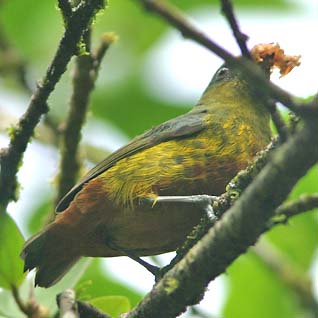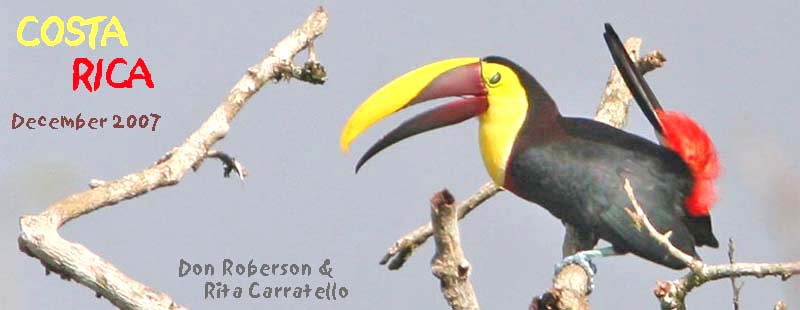
near Puerto Viejo 19 Dec 2007
This is an annotated Costa Rica trip list from our two-week visit in late December 2007. Excluded the two days flying to and from San Jose, we had 12 days in Costa Rica. We visited only three primary sites (1-3 below), plus traveled between sites, and had a brief afternoon in San Jose (#4):
Species heard only are included on main list if it was a species we knew or with which we had experience. "Heard only" species pointed out to us solely by guides are listed in an appendix. We had 284 native species, plus two non-native introduced birds [in brackets]. Another 9 birds (Appendix) were "heard only" and not counted. Together, the sum is 295 birds. |
||||
Those species photographed are followed by "[ph]" (113 birds). Lifers for me have an asterisk after Latin name. |
||||
| Great Tinamou Crypturellus major: heard daily at La Selva but not seen Little Tinamou Crypturellus soui: one came daily to rice thrown out by the kitchen at Rio Tigre; also heard there widely, including throughout the night (ph) Black-bellied Whistling-Duck Dendrocygna autumnalis: a pair with young at Dos Brazos, the little town near Bosque del Rio Tigre (ph) Gray-headed Chachalaca Ortalis cinereiceps: a group of 8 or so was foraging in trees along the river near Rio Tigre (ph) Crested Guan Penelope purpurascens: heard daily at La Selva; Rita saw one Black Guan Chamaepetes unicolor: one was foraging in the 'quetzal tree' (a wild avocado) shortly after dawn (phs); another was seen hiking during a hike above Savegre Great Curassow Crax rubra *: a male was standing on a log in the river at La Selva, until it took flight (ph) Marbled Wood-Quail Odontophorus gujanensis: Don watching one walking through the forest at Rio Tigre Brown Pelican Pelecanus occidentalis: several in flight over Golfo Dulce Magnificent Frigatebird Fregata magnificens: one male and a female in flight over Golfo Dulce Fasciated Tiger-Heron Tigrisoma fasciatum *: one flushed from Rio Pizote into a tree for great views (ph) Bare-throated Tiger-Heron Tigrisoma mexicanum: two in wet farm fields at P. Viejo de Sarapiqui Great Egret Ardea alba: scattered birds on lowlands of both sides Snowy Egret Egretta thula: a few near Rio Tigre Little Blue Heron Egretta caerulea: a few near Rio Tigre Tricolored Heron Egretta tricolor: one along Rio Rincon, Osa Peninsula Cattle Egret Bubulcus ibis: common and widespread in lowlands Green Heron Butorides virescens: one flew across Rio Rincon White Ibis Eudocimus albus: one right at Rio Tigre, 8 more on Rio Rincon |
||||
 Tricolored Heron, White Ibis, Snowy Egret in Rio Tigre: some of the very few waterbirds seen in what was a forest-birding trip |
||||
Black Vulture Coragyps atratus: common and widespread (ph)
|
||||
|
||||
| Roadside Hawk Buteo magnirostris: a few most days on Osa Peninsula in open country Broad-winged Hawk Buteo platypterus: an adult perched at El Tapir near Braulio Carrillo NP Gray Hawk Buteo nitidus: one at La Selva Short-tailed Hawk Buteo brachyurus: a single adult light-morph was seen flying behind Posada Andrea Christina on two afternoons Red-tailed Hawk Buteo jamaicensis: one seen from Mirador Cinchona Ornate Hawk-Eagle Spizaetus ornatus *: a subadult spotted by our guide Kenneth Alfonso at La Selva was a major highlight of our morning walk. He got on the radio and workers and staff came running to see it as it perched in the compound for a quarter-hour (many photos). Crested Caracara Caracara cheriway: a few in open areas around P. Viejo de Sarapiqui (ph) Yellow-headed Caracara Milvago chimachima: a few most days in open areas around Osa Peninsula Bat Falcon Falco rufigularis: a stake-out pair were seen every visit to farm fields near P. Viejo (ph) Gray-necked Wood-Rail Aramides cajanea: one came to ground feeder by Rio Tigre lodge (ph), two others crossed road near Dos Brazos Uniform Crake Amaurolimnas concolor *: one glimpsed running away into forest at the edge of the flooded 'lagoon' near Rio Tigre; the species becomes reasonably 'easy' here during the dry season in Mar-Apr Purple Gallinule Porphyrio martinica: several in marshes on Osa Peninsula Semipalmated Plover Charadrius semipalmatus: a half-dozen on sandbars in Rio Rincon Northern Jaçana Jacana spinosa: a few in marshes in both Atlantic & Pacific lowlands Spotted Sandpiper Actitis macularius: one on Rio Tigre, a few more on Rio Rincon Whimbrel Numenius phaeopus: two on sandbars in Rio Rincon Least Sandpiper Calidris minutilla: small flock on sandbars in Rio Rincon [Rock Pigeon Columba livia: this non-native Introduced species seen in larger cities & towns] Pale-vented Pigeon Patagioenas cayennensis: a couple in flight behind Posada Andrea Christina Red-billed Pigeon Patagioenas flavirostris: a flock in flight enroute to Cinchona Band-tailed Pigeon Patagioenas fasciata: a very few around Savegre Lodge Ruddy Pigeon Patagioenas subvinacea: two perched in San Gerardo Valley, upstream of Savegre (ph) Short-billed Pigeon Patagioenas nigrirostris: common in lowlands both sides, in forest, heard all day (ph) Ruddy Ground-Dove Columbina talpacoti: common in Pacific lowlands (ph), fewer but easy on Atlantic side Blue Ground-Dove Claravis pretiosa: a male came daily to ground feeder at Rio Tigre (ph), a few others seen or heard around Osa Peninsula White-tipped Dove Leptotila verreauxi: a few daily seen on Osa Peninsula; also a couple at La Selva vicinity. One chunky dove in flight might have been Olive-backed Quail-Dove Geotrygon veraguensis but I was unable to confirm that. Gray-chested Dove Leptotila cassini: a few daily at ground feeder next to Rio Tigre lodge (ph) |
||||
|
||||
| Sulphur-winged Parakeet Pyrrhura hoffmanni: a small flock of 8-12 seen most days around Savegre Crimson-fronted Parakeet Aratinga finschi: a small flock seen in flight from taxi enroute to Rio Tigre Olive-throated Parakeet Aratinga nana *: a dozen or more scattered around La Selva and vicinity (ph) Great Green Macaw Ara ambiguus *: we tried twice at the farm fields with fruiting almond trees with Alex Martinez (but in rain) and with Kevin Martinez. The latter effort was near dusky and by walking out into the fields (paying $5/each) we flushed a pair and got wonderful views as the sun set (ph). Alex Martinez is very active in the effort to protect them in these Atlantic lowlands. Scarlet Macaw Ara macao: a pair heard and poorly seen in farm fields near P. Viejo de Sarapiqui. Alex Martinez advises that they are re-establishing their range here where they have been absent ~50 years. The species remains common on Osa Peninsula, where we had up to 40/day along Rio Tigre (ph). Orange-chinned Parakeet Brotogeris jugularis: common in lowlands, both Atlantic & Pacific sides Brown-hooded Parrot Pionopsitta haematotis: small flocks encountered twice at Rio Tigre White-crowned Parrot Pionus senilis: one in flight across the waterfall view from Mirador Cinchona was quite a lovely site! Small flocks encountered twice at Rio Tigre, once perched in canopy of small tree Red-lored Parrot Amazona autumnalis: a few daily around La Selva, also a few at Rio Tigre Mealy Parrot Amazona farinosa: a few daily around La Selva, also daily at Rio Tigre Squirrel Cuckoo Piaya cayana: singles seen on both visits to Braulio Carrillo NP Striped Cuckoo Tapera naevia: one watched singing from a low open branch near P. Jimenez, Osa Peninsula Smooth-billed Ani Crotophaga ani: common in open land on Osa Peninsula Groove-billed Ani Crotophaga sulcirostris: common in open land around P. Viejo de Sarapiqui Black-and-white Owl Ciccaba nigrolineata: an owl heard every night along the river at Rio Tigre was probably his species. It only gave single hoots, but those match one portion of one tape fairly well. Efforts to locate it were unsuccessful. Don heard another owl at Posada Andrea Christina one night, but it moved away quickly. It was a series of hoots. Although Vermiculated Screech-Owl Megascops guatemalae is in range, the calls weren't right. So it remains a mystery. Common Pauraque Nyctidromus albicollis: heard from a P. Viejo restaurant at dusk, and nightly at Rio Tigre White-collared Swift Streptoprocne zonaris: small flocks daily at Savegre, much larger flocks (100+) daily at Rio Tigre Costa Rican Swift Chaetura fumosa *: a few most days at Rio Tigre, often with flocks of WC Swifts (ph) Gray-rumped Swift Chaetura cinereiventris: small Chaetura swifts over La Selva were likely this species |
||||
|
||||
Band-tailed Barbthroat Threnetes ruckeri: a few around Rio Tigre lodge and trail to 'lagoon'
Stripe-throated Hermit Phaethornis striigularis:
this is a fairly recent split from Little Hermit P. longuemareus; it
was found daily around La Selva, and once at Rio Tigre (ph) |
||||
|
||||
| White-necked Puffbird Notharchus macrorhynchos: one perched in forest at La Selva (ph) Rufous-tailed Jacamar Galbula ruficauda: seen at La Selva, heard at Rio Tigre, but each avoided my camera Red-headed Barbet Eubucco bourcierii: pair in mixed flock at upper foothills, B. Carrillo NP Prong-billed Barbet Semnornis frantzii: a half-dozen came to feeders at Cinchona (ph) Emerald Toucanet Aulacorhynchus prasinus: one at Cinchona feeder (ph) and another in San Gerardo Valley near Savegre were it. These were of the blue-throated subspecies caeruleogularis Collared Araçari Pteroglossus torquatus: a handful in the lowlands at and around La Selva (ph) Fiery-billed Araçari Pteroglossus frantzii: two in cut-over forest near Rio Rincon, Osa Peninsula. Alas, they got away before photos Keel-billed Toucan Ramphastos sulfuratus: fairly common at La Selva (ph) Chestnut-mandibled Toucan Ramphastos swainsonii: common and conspicuous in lowland forests, both sides. Most impressive was watching a long, full display of a calling male near La Selva (ph) Acorn Woodpecker Melanerpes formicivorus: this familiar species was conspicuous at Savegre (ph) Golden-naped Woodpecker Melanerpes chrysauchen *: guide Luis Sandoval at Rio Tigre took me to the one tree that they were still known to use regularly, and I saw a pair; was able to show one to Rita the next day. This limited range species appears to be declining on the Osa Peninsula (ph) Black-cheeked Woodpecker Melanerpes pucherani: seen daily in the Atlantic lowlands (ph) Red-crowned Woodpecker Melanerpes rubricapillus: common daily on the Osa Peninsula, Pacific lowlands Hoffmann's Woodpecker Melanerpes hoffmannii *: a male and female were seen in the gardens of Hotel Buena Vista on our final afternoon in San Jose, the only species seen in San Jose and nowhere else. Hairy Woodpecker Picoides villosus: a couple heard calling above Savegre Chestnut-colored Woodpecker Celeus castaneus: a pair were foraged on a huge epiphyte-laden tree at La Selva during our early morning walk with guide Kenneth Lineated Woodpecker Dryocopus lineatus: one in flight on the Osa Peninsula Pale-billed Woodpecker Campephilus guatemalensis: Rita saw one at Rio Tigre Ruddy Treerunner Margarornis rubiginosus: several were with mixed flocks along the Quebrada Trail above Savegre Striped Woodhaunter Hyloctistes subulatus *: one with a mixed flock along the Los Palmas Trail at Braulio Carrillo NP was an unexpected treat; it was foraging among the large epiphytes Buff-throated Foliage-gleaner Automolus ochrolaemus: a few daily in mixed flocks in the forest at Rio Tigre (ph) Plain Xenops Xenops minutus: Rita and I saw singles on two separate days in the forest at Rio Tigre (ph) Tawny-winged Woodcreeper Dendrocincla anabatina: Rita and I got to see one on different days at Rio Tigre. In both cases, Liz heard it calling near the office, and Abram took us over to get views. Don's was near dusk and the woodcreeper was actively battling a Red-crowned Woodpecker over a hole, which was either related to a roost hole or (possibly) a potential nest hole Ruddy Woodcreeper Dendrocincla homochroa: a single seen with mixed flock along Los Palmas Trail at Braulio Carrillo NP Wedge-billed Woodcreeper Glyphorhynchus spirurus: single at B. Carrillo NP and another foraging on a tree in Rio Tigre lodge's front garden (ph) Northern Barred-Woodcreeper Dendrocolaptes sanctithomae *: now split from Amazonian Basin barred woodcreepers, this large bird was with a mixed flock in the forest at Rio Tigre. The race here looks mostly unbanded in the field Cocoa Woodcreeper Xiphorhynchus susurrans: scattered individuals in lowland forest on both Atlantic and Pacific sides; this is a split from Buff-throated Woodcreeper Streak-headed Woodcreeper Lepidocolaptes souleyetii: a few in lowland rainforest on both sides Spot-crowned Woodcreeper Lepidocolaptes affinis: several daily in cloud forest at Savegre Fasciated Antshrike Cymbilaimus lineatus: one male was seen very well at La Selva Black-hooded Antshrike Thamnophilus bridgesi *: this is the common antshrike on the Osa Peninsula, occurring primarily in pairs, sometimes with mixed flocks and sometimes foraging alone. Could be difficult to see but we ended up seeing a fair number (ph) Western Slaty-Antshrike Thamnophilus atrinucha: pair seen at Braulio Carrillo NP; also heard at La Selva Dot-winged Antwren Microrhopias quixensis: fairly common component of mixed flocks in forest on Osa Peninsula (ph) Chestnut-backed Antbird Myrmeciza exsul: present every day in the forest behind Rio Tigre lodge (ph) Bicolored Antbird Gymnopithys leucaspis: Don had a pair, with Luis, in a mixed flock at Rio Tigre (ph); Abram showed Rita another on our final morning there Black-faced Antthrush Formicarius analis: one watching walking on the forest floor at Rio Tigre. It was calling in close proximity to a calling Chestnut-backed Antbird, and their calls were remarkably similar |
||||
|
||||
| Yellow-bellied Elaenia Elaenia flavogaster: a couple at forest edge at Rio Tigre Mountain Elaenia Elaenia frantzii: a few around Savegre (ph), where they ate berries Torrent Tyrannulet Serpophaga cinerea: enroute to Cinchona, we saw one perched on a rock in a rushing stream from one of the bridge along the road Olive-striped Flycatcher Mionectes olivaceus: one at Mirador Cinchona Ochre-bellied Flycatcher Mionectes oleagineus: a few in lowland forests at La Selva and Rio Tigre Paltry (Mistletoe) Tyrannulet Zimmerius vilissimus: a few daily in bushes around La Selva hdqs; also at Rio Tigre Northern Bentbill Oncostoma cinereigulare: Rita and I saw one nicely in understory at Rio Tigre Common Tody-Flycatcher Todirostrum cinereum: common at forest edge in lowlands, both sides (ph) Eye-ringed Flatbill Rhynchocyclus brevirostris: I was surprised to find singles twice with loose flocks in the forest at Rio Tigre (ph) Golden-crowned Spadebill Platyrinchus coronatus *: an adult carrying nesting material perched within a foot of Luis and me inside the forest at Rio Tigre Sulphur-rumped Flycatcher Myiobius sulphureipygius: one with a mixed flock in forest at Rio Tigre (ph) Tufted Flycatcher Mitrephanes phaeocercus: a few around Savegre (ph) Dark Pewee Contopus lugubris: one in forest near Savegre gave us fine views Yellow-bellied Flycatcher Empidonax flaviventris: one foraging right in the front yard of Rio Tigre lodge on our final morning (ph) Willow Flycatcher Empidonax traillii: one foraging at forest edge at Rio Rincon was clearly a Willow/Alder E. traillii/alnorum type. We were actually leaning toward Alder due to its greener tones (at least compared to western Willows we see regularly) but the literature states that Alders do not winter locally in Costa Rica. Ergo, it is almost certainly a Willow at this date (27 Dec) and, given its color tone, almost certainly an eastern bird Yellowish Flycatcher Empidonax flavescens: a couple around Savegre Black-capped Flycatcher Empidonax atriceps: seen daily in small numbers at Savegre (ph) Black Phoebe Sayornis nigricans: one along stream at Savegre Long-tailed Tyrant Colonia colonus: one in open country near P. Viejo Bright-rumped Attila Attila spadiceus: several seen at La Selva -- one of them caught a gecko right in front of the La Selva dining hall (ph) – and heard daily at Rio Tigre Rufous Mourner Rhytipterna holerythra: nice views of a couple at La Selva Dusky-capped Flycatcher Myiarchus tuberculifer: a few daily around La Selva Great Crested Flycatcher Myiarchus crinitus: singles seen at La Selva and Rio Tigre, the latter eating a dragonfly (!) Great Kiskadee Pitangus sulphuratus: common and conspicuous throughout lowlands, both sides (ph) Boat-billed Flycatcher Megarhynchus pitangua: a few seen or heard in Atlantic lowlands & foothills Social Flycatcher Myiozetetes similis: common in lowlands, both sides Gray-capped Flycatcher Myiozetetes granadensis: common on Osa Peninsula, some also at La Selva (ph) Tropical Kingbird Tyrannus melancholicus: common and conspicuous in both lowlands and mountains Rufous Piha Lipaugus unirufus: one watched calling in forest at Rio Tigre Cinnamon Becard Pachyramphus cinnamomeus: two in mangroves at Rio Rincon Rose-throated Becard Pachyramphus aglaiae: single males seen on a couple of days inside forest at Rio Tigre; the subspecies here does not have rose on the throat (ph) |
||||
|
||||
| Masked Tityra Tityra semifasciata: a few at or near La Selva Turquoise Cotinga Cotinga ridgwayi *: two females were scoped from Rio Tigre lodge as they sat atop a tall bare tree across the river (ph) Yellow-billed Cotinga Carpodectes antoniae *: this much-wanted species was in evidence around the Rio Rincon mangroves, where we tallied 5 males and a female (ph) Snowy Cotinga Carpodectes nitidus *: a male sat atop a tall bare tree at the edge of the La Selva clearing (ph) Orange-collared Manakin Manacus aurantiacus *: there is a fabulous display ground uphill from Rio Tigre, where we could watch up to 9 males daily in display (ph) Red-capped Manakin Pipra mentalis: a female visited the feeder at Rio Tigre (ph); there is a lekking locale behind the lodge but the males were not yet using it during our visit Yellow-throated Vireo Vireo flavifrons: singles at La Selva and Rio Tigre Yellow-winged Vireo Vireo carmioli: a few around Savegre Philadelphia Vireo Vireo philadelphicus: several on Osa Peninsula, both at Rio Tigre and Rio Rincon Tawny-crowned Greenlet Hylophilus ochraceiceps: a few in the forest behind Rio Tigre lodge Lesser Greenlet Hylophilus decurtatus: several in scrub forest-edge at Rio Tigre Green Shrike-Vireo Vireolanius pulchellus: one heard on several days at Rio Tigre; I did not try to track it down Gray-breasted Martin Progne chalybea: one at La Selva Mangrove Swallow Tachycineta albilinea: common in mangrove area at Rio Rincon (ph) Blue-and-white Swallow Pygochelidon cyanoleuca: common in upper foothills (Cinchona) and mountains (ph) Band-backed Wren Campylorhynchus zonatus: pair along entrance road into La Selva (ph) Black-throated Wren Thryothorus atrogularis *: pair seen with guide Kenneth at La Selva Black-bellied Wren Thryothorus fasciatoventris: one seen in forest at Rio Tigre Riverside Wren Thryothorus semibadius *: a rather common but skulking wren at Rio Tigre Stripe-breasted Wren Thryothorus thoracicus *: one seen on Los Palmas Trail, B. Carrillo NP Plain Wren Thryothorus modestus: we watched one at length in brushy farm fields near P. Viejo House Wren Troglodytes aedon: rather common in open country in lowlands, both sides Gray-breasted Wood-Wren Henicorhina leucophrys: several daily at Savegre, but often very hard to see; another was viewed from the balcony at Cinchona as it ventured into the open (ph) |
||||
|
||||
| Black-faced Solitaire Myadestes melanops: Don got fine views of one perched in forest along Quebrada Trail above Savegre; others heard Black-billed Nightingale-Thrush Catharus gracilirostris: two seen on Quebrada Trail above Savegre Ruddy-capped Nightingale-Thrush Catharus frantzii: one seen from dining room window at Savegre, another in forest above lodge Wood Thrush Hylocichla mustelina: one was regularly foraging on the grounds of Posada Andrea Christina; more were seen in the forest at La Selva Sooty Robin Turdus nigrescens: several daily around Savegre (ph) Mountain Robin Turdus plebejus: quite common at Savegre (ph) Pale-vented Thrush Turdus obsoletus *: one seen very well in the forest at Braulio Carrillo NP Clay-colored Robin Turdus grayi: the national bird of Costa Rica was common and widespread everywhere except the high mountains; only one seen at Savegre (ph) White-throated Robin Turdus assimilis: singles at Rio Tigre on separate days Black-and-yellow Silky-Flycatcher Phainoptila melanoxantha *: there were 3-4 female or imms with a mixed canopy flock along the Quebrada Trail above Savegre. I was able to watch these at length as they sallied out like flycatchers for a time, and then started to eat small berries. The flock they were with soon left them behind, eating berries in the canopy above me. An unexpected highlight! Long-tailed Silky-Flycatcher Ptilogonys caudatus: one frequented a fruiting bush outside the reception desk at Savegre; the manager pointed it out to us as we were checking in! Golden-winged Warbler Vermivora chrysoptera: Rita and our guide Kenneth saw one briefly at La Selva; Don missed it entirely. Tennessee Warbler Vermivora peregrina: a half-dozen or more at Savegre, and one in a B. Carrillo flock Yellow Warbler Dendroica petechia: Rita had one at P. Viejo; a couple more were in mangroves near P. Jimenez on the Osa Peninsula. All seemed to be wintering birds from N. America Chestnut-sided Warbler Dendroica pensylvanica: this is the common wintering warbler throughout Costa Rica. We saw it daily in good numbers in lowlands; fewer in highlands but still present Black-throated Green Warbler Dendroica virens: several in mixed flocks at B. Carrillo NP and Savegre Townsend's Warbler Dendroica townsendi: one along Provencia Rd in cloud forest, plus one at Savegre Blackburnian Warbler Dendroica fusca: a few in mixed flock in Braulio Carrillo NP Black-and-white Warbler Mniotilta varia: Rita saw one at Braulio Carrillo NP Northern Waterthrush Seiurus noveboracensis: a few at La Selva and vicinity (including one walking on the compound lawn); another in Osa Peninsula mangroves Olive-crowned Yellowthroat Geothlypis semiflava: several singing in swampy grasslands near P. Viejo (ph) Wilson's Warbler Wilsonia pusilla: the common warbler at Savegre and above, often the dominant species seen in mixed flocks Collared Redstart Myioborus torquatus: common and often conspicuous in forest at Savegre (ph) Black-cheeked Warbler Basileuterus melanogenys: fairly common in mixed canopy flocks along Quebrada Trail above Savegre Buff-rumped Warbler Phaeothlypis fulvicauda: one working a paved path through La Selva; a couple more along the Rio Pizote on Osa Peninsula (ph) Wrenthrush Zeledonia coronata *: this much-wanted species was finally seen briefly (and others heard) along the Quebrada Trail above Savegre. The short-tailed long-legged little gnome flushed from the edge of the creek, giving its thin high-pitched call as it flew Bananaquit Coereba flaveola: common and conspicuous in lowlands, both sides Common Bush-Tanager Chlorospingus ophthalmicus: a couple at forest edge at Braulio Carrillo NP Sooty-capped Bush-Tanager Chlorospingus pileatus: quite common in small flocks at Savegre (ph) |
||||
|
||||
Olive Tanager Chlorothraupis carmioli: a handful at La Selva and B. Carrillo NP Gray-headed Tanager Eucometis penicillata: small parties were with mixed undergrowth flocks inside the forest at Rio Tigre (ph) White-shouldered Tanager Tachyphonus luctuosus: a few daily in mixed flocks in the forest at Rio Tigre Tawny-crested Tanager Tachyphonus delattrii: small party in undergrowth at Braulio Carrillo NP, with next species Red-throated Ant-Tanager Habia fuscicauda: a pair or two in the undergrowth at B. Carrillo NP Black-cheeked Ant-Tanager Habia atrimaxillaris *: this much-wanted Costa Rican endemic was regular, and often noisy, inside the forest at Rio Tigre; a few birds also came to the back feeder each day (ph) Summer Tanager Piranga rubra: fairly common in lowlands and seen or heard every day there; some up into the foothills to B. Carrillo NP and Mirador Cinchona (ph, below) |
||||
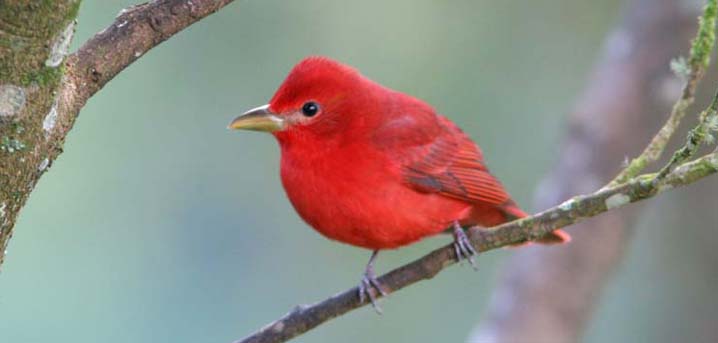 |
||||
| Flame-colored Tanager Piranga bidentata: a few (4-8) daily around Savegre lodge; sometimes at the hummingbird feeders (ph) Passerini's Tanager Ramphocelus passerinii: the former "Scarlet-rumped Tanager" has been split into two species. The males are essentially identical but females are easily distinguished. This is the Caribbean lowland species; it is common and conspicuous at La Selva and at the feeder at Posada Andrea Christina (ph) Cherrie's Tanager Ramphocelus costaricensis: this is the Pacific slope split of "Scarlet-rumped Tanager;" it is common and conspicuous at forest edge and in gardens around Rio Tigre (ph) Blue-gray Tanager Thraupis episcopus: common open country species in lowlands of both sides, and often at feeders (ph) Palm Tanager Thraupis palmarum: rather common in Caribbean lowlands; a few in Pacific lowlands Blue-and-gold Tanager Bangsia arcaei *: about 3 in mixed flock at edge of 'El Tapir' garden, near B. Carrillo NP Plain-colored Tanager Tangara inornata: several on a couple days around La Selva Emerald Tanager Tangara florida: two in mixed flock at 'El Tapir' garden, near B. Carrillo NP Silver-throated Tanager Tangara icterocephala: reasonably common in foothills and mountains, from B. Carrillo NP and Mirador Cinchona, to Savegre. Came to feeders at Cinchona (ph) Speckled Tanager Tangara guttata: several in mixed flock at 'El Tapir' garden, near B. Carrillo NP Bay-headed Tanager Tangara gyrola: a few daily in the forest at Rio Tigre |
||||
|
||||
Golden-hooded Tanager Tangara larvata: fairly common in the lowlands on both sides; sometimes at feeders (ph) |
||||
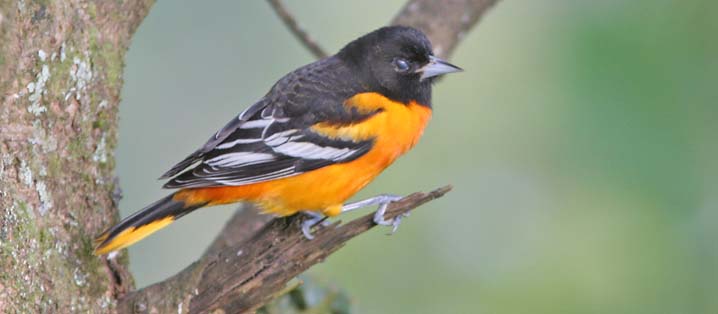 |
||||
| Scarlet-rumped Cacique Cacicus uropygialis: heard at La Selva, and finally nicely seen at Rio Rincon Montezuma Oropendola Psarocolius montezuma: common in Caribbean lowlands Thick-billed Euphonia Euphonia laniirostris: a female seen along Rio Pizote, Osa Peninsula Spot-crowned Euphonia Euphonia imitans *: a few daily at Rio Tigre, almost all at the feeder that was visited by both males and females (ph) Olive-backed Euphonia Euphonia gouldi *: small party of males and females was foraging in a fruiting tree at La Selva (ph); also another near P. Viejo White-vented Euphonia Euphonia minuta: male and two females in Braulio Carrillo NP Tawny-capped Euphonia Euphonia anneae *: a pair in mixed flock at forest edge at 'El Tapir,' adjacent to B. Carrillo NP Golden-browed Chlorophonia Chlorophonia callophrys: Don briefly saw a male in a mixed flock at forest edge on the final morning at Savegre [ House Sparrow Passer domesticus: non-native Introduced species seen in some towns ] |
||||
|
||||
APPENDIX: "Heard only" bird species pointed out solely by guides, and vocalizations not known to us:
|
||||
MAMMALS [nearly every species was photographed; see Mammals page] Hoffman's Two-toed Sloth Choloepus hoffmanni: a female with well-grown baby at Posada Andrea Christina, P. Viejo, and an adult at Rio Rincon on Osa Peninsula (ph) AMPHIBIANS & REPTILES [all the following species were photographed; see Herp page] Amphibians ODONATES [Dragonflies & Damselflies] |
||||
Literature cited:
|
INTRODUCTION TO COSTA RICA TRIP Dec 2007 |
|
Atlantic Lowlands LA SELVA |
|
Montane Cloud Forest SAVEGRE |
HERPS Reptiles & Amphibians |
Pacific Lowlands RIO TIGRE |
ODES Dragonflies & Damselflies |
Complete TRIP LIST with birds, mammals & herps |
|
page created 25-27 Jan 2008
|
© Don Roberson 2008 |
